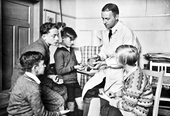Ludwig Hirschfeld-Mack
Ludwig Hirschfeld-Mack (born July 11, 1893 in Frankfurt am Main ; † January 7, 1965 in Sydney , Australia ) was a German painter and "colored light musician" .
Professional career
Ludwig Hirschfeld-Mack first attended the Musterschule , a musical high school in Frankfurt am Main. He received his artistic training in the teaching and experimental studio for applied and free art with Hermann Obrist and Wilhelm von Debschitz from 1912 to 1914 at the Debschitz School in Munich. He attended lectures on art history from Heinrich Wölfflin and Fritz Burger . During the First World War , Ludwig Hirschfeld-Mack was an infantry officer from 1914 to 1918.
In 1920 he became an apprentice for art prints at the Bauhaus in Weimar. His journeyman he graduated in 1921 in the copper pressure and was simultaneously Etat journeyman in the graphic printing of the Bauhaus, where he became a journeyman in 1922 and 1924 representatives finally as Bauhaus apprentice his trade test in lithography and lithographic took off. He stayed there until 1926 and his activities revolved around extra-curricular color seminars, color spinning tops, his educational doll's house and the reflective color light games developed with Kurt Schwerdtfeger .
In April 1926 Ludwig Hirschfeld-Mack became an art teacher in the Free School Community of Wickersdorf , where he worked until March 1928. In 1929 he got a job at the State College for Crafts and Architecture in Weimar as a teacher for general color and form theory. Just one year later, in 1930, he received a professorship at the Pedagogical Academy in Frankfurt (Oder) (the building is now used by the Gauß-Gymnasium ). Hirschfeld-Mack, together with the former Bauhaus master Gertrud Grunow, participated in the II. Congress for Color and Clay Research in Hamburg in 1930. In 1932 he taught at the Pedagogical Academy in Kiel , which, however, was converted by the National Socialists into a college for teacher training (HfL) based on their ideology . He went to the Jöde School / Günther School in Berlin until 1935 , where he occupied himself with the students and with the construction of simple musical instruments.
In 1936 Mack emigrated to England. He taught arts and crafts at the Subsistence Production Society of the Eastern Valley of Monmouthshire in South Wales . His daughter Marga followed him into exile in England in 1936, the other daughter Ursel (17) committed suicide in 1937 under the impression of increasing reprisals in Germany. In 1940 Ludwig Hirschfeld-Mack was deported to Australia as an enemy alien on the ship HMT Dunera and interned there in the camps Hay, Tatura and Orange. He now took on the Australian citizenship. Until his retirement at the Geelong Church of England Grammar School in Victoria , he was director of the art school and visiting lecturer at Melbourne University . He went on various trips to Europe and pushed ahead with the revival of the colored light plays. Ludwig Hirschfeld-Mack died in Sydney on January 7, 1965.
Hirschfeld-Mack professorships in Germany and Australia
In 2008, a Ludwig Hirschfeld-Mack Visiting Chair of Australian Studies was established at the Institute for English Philology at the Free University of Berlin (FU). The visiting professorship is named after Hirschfeld-Mack, according to the FU, "to stress the interdisciplinary nature of its teachers, their commitment to the role of culture in the public sphere, and the central transcultural German-Australian aspect of the project." The chair is financed by the German Academic Exchange Service (DAAD) and the Australian Embassy Berlin. Previous Hirschfeld-Mack professors in Berlin were Stephen Muecke, Professor of Cultural Studies at the University of Technology Sydney (winter semester 2008/09) and Philip Mead, Professor of Australian Literature at the University of Western Australia, Perth (winter semester 2009/10) .
In 2010, also with the support of the DAAD, a Hirschfeld-Mack Visiting Professorship for German Studies was established at the German Department of the University of Western Australia in Perth. This "tandem" guest professorship is intended to further intensify the exchange between the Australian and German higher education systems. The first Hirschfeld-Mack professors in Perth were the German scholars Matthias N. Lorenz , University of Bern (2010), Sven Kramer, Leuphana University of Lüneburg (2011) and Helmut Peitsch, University of Potsdam (2012).
literature
- Andreas Hapkemeyer, Peter Stasny (eds.): Ludwig Hirschfeld-Mack. Bauhausler and visionary. Hatje Cantz, Ostfildern 2000, ISBN 978-3-7757-0928-6 .
- Josef Straßer: 50 Bauhaus icons that you should know. Prestel, Munich 2009, pp. 80f.
- Ulla Heise: Hirschfeld-Mack, Ludwig . In: General Artist Lexicon . The visual artists of all times and peoples (AKL). Volume 73, de Gruyter, Berlin 2011, ISBN 978-3-11-023178-6 , pp. 343-345.
- Hirschfeld-Mack, Ludwig , in: Werner Röder; Herbert A. Strauss (Ed.): International Biographical Dictionary of Central European Emigrés 1933-1945 . Volume 2.1. Munich: Saur, 1983 ISBN 3-598-10089-2 , p. 519
Web links
- Literature by and about Ludwig Hirschfeld-Mack in the catalog of the German National Library
Individual evidence
- ↑ Peter Dudek: "Experimental field for a new youth". The Free School Community of Wickersdorf 1906–1945 . Julius Klinkhardt, Bad Heilbrunn 2009, ISBN 978-3-7815-1681-6 , pp. 11-12.
- ^ Free University of Berlin: Ludwig Hirschfeld-Mack Guest Chair for Australian Studies. ( Memento of the original of July 13, 2015 in the Internet Archive ) Info: The archive link was automatically inserted and not yet checked. Please check the original and archive link according to the instructions and then remove this notice. October 15, 2008. Retrieved August 19, 2010
- ^ Ludwig Hirschfeld-Mack Visiting Chair for Australian Studies : Visiting Professors . Retrieved August 19, 2010
| personal data | |
|---|---|
| SURNAME | Hirschfeld-Mack, Ludwig |
| ALTERNATIVE NAMES | Hirschfeld, Ludwig; Hirschfeld Mack, Ludwig |
| BRIEF DESCRIPTION | German-Australian artist |
| DATE OF BIRTH | July 11, 1893 |
| PLACE OF BIRTH | Frankfurt am Main , Germany |
| DATE OF DEATH | January 7, 1965 |
| Place of death | Sydney , Australia |

